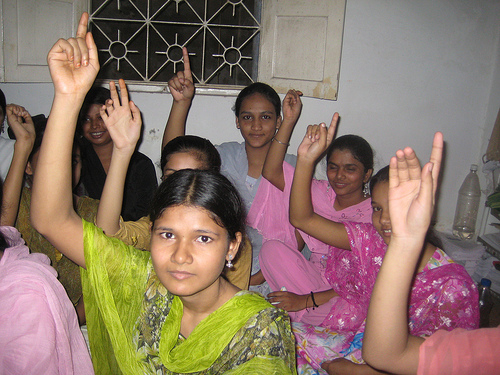Saturday, April 20, 2024
News and Views from the Global South
Despite Rhetoric, Women Still Sidelined in Development Funding
- As U.N. Deputy Secretary-General Asha-Rose Migiro once put it, “Women hold the keys to unlocking the barriers to sustainable development.”

Women in Muslim-dominated Metiabruz district in eastern India look forward to better opportunities after their IT education. Credit: Ranjita Biswas/IPS
Women play essential roles in the global economy, agriculture and development. But while the rhetoric regarding the importance of women’s inclusion in development projects has peaked in recent years, actual gender-inclusion in investment projects often fails to walk the talk.
The main challenges facing sustainable development in the future are gender inequality, climate change, natural resource degradation and the global recession, said Melanne Verveer, U.S. Department of State ambassador-at-large for global women’s issues, at a recent conference on gender equity and sustainable development.
“No effort to advance sustainable development will succeed that does not take into account half of the world’s population,” she said. “Women have long been promoting solutions to sustainable development challenges. They’ve been promoting climate change adaptation and mitigation, protecting biodiversity and vital ecosystems, securing water access, and combating indoor air pollution.”
According to the United States Agency for International Development (USAID), women are responsible for half of the world’s food production. And they continue to bear most of the responsibilities at home, from caring for children to providing meals. Therefore, women’s participation is vital to the success of sustainable development projects.
However, while acknowledging the importance of gender equality for development, the World Bank and other international financial institutions (IFIs) continue to make gender-insensitive decisions, Elaine Zuckerman, the head of Gender Action, told IPS.
“A lot of people propose gender equality, women’s rights, women’s empowerment, but then when you look at what is budgetised, where the funds go, there is a huge disconnect. I think it’s critical to translate the rhetoric into investments… A lot of IFI staff don’t still, but those who do often speak in a vacuum,” Zuckerman told IPS.
IFIs still view gender as a “soft issue”, Elizabeth Arend, programmes coordinator for Gender Action, told IPS.
In 2011, while the World Bank’s World Development Report (WDR) highlighted gender issues, the Bank’s budget for “social development, gender and inclusion” investments decreased to 908 million dollars from 952 million in 2010. The Bank’s spending in this thematic category represents less than two percent of its 2011 budget, Arend noted.
“It is not enough to have a handful of ‘gender experts’ in an institution like the World Bank… nor is it permissible to address gender in a single paragraph within a 160-page project appraisal document. IFIs must understand that every component of every project in every sector has gender implications, and that marginalising gender issues fundamentally undermines the effectiveness and sustainability of IFI investments,” Arend told IPS.
Many IFI projects fail to address gender inequalities that prevent women and girls from participating and benefiting from project activities, experts say. And women tend to disproportionately suffer when gender inequalities are not included in development project designs, as exemplified by the World Bank-financed West African and Chad-Cameroon pipelines project.
Research by Gender Action in partnership with Friends of the Earth found that because gender dimensions were not taken into account in the project, “IFIs reinforced (existing) second-class status by sidelining women in consultation processes, discriminating against women in compensation schemes and employment opportunities, and undermining women’s critical livelihoods.”
Arend believes there are several reasons for the World Bank’s persistent gap between gender equality rhetoric and actual funding. First is the historic discrepancy between what the Bank’s research team prioritises and what actually gets funded. Secondly, if the leadership doesn’t see gender as a priority, then gender simply will not be integrated in the Bank’s investments. Finally, the Bank is ultimately a business.
“The World Development Report provides an example. Gender Action’s founder, Elaine Zuckerman, has followed WDRs since their inception and has (hardly) seen a correlation between the WDR and actual funding. This holds true for the Gender Equality and Development WDR as well. While the Bank is busy promoting this report and its findings, in addition to its ‘Think Equal’ social media campaign, it is not investing more in gender at all,” Arend said.
However, this situation might be slowly changing. Arend noted that the Bank has committed 40 million dollars to re-launch a “strengthening agriculture public services project” in Haiti following the original project in 2009.
The new project has “developed a financial literacy programme for women agriculture producers and traders, strengthened the agriculture ministry team’s capacity on gender issues and supported the integration of a Gender Focal Point into the ministry” as requested by female beneficiaries.
“The (Haiti) project is far from perfect, but this shows that the World Bank is capable of making investments in a gender-sensitive manner. All that seems to be lacking is the will,” Arend said.

 Print
Print



